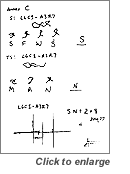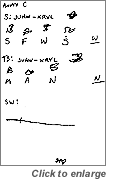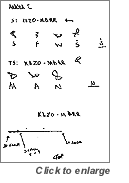 |
 |
 |

NEWS: Analysis & Commentary
Page 2
RV Theory: Determining Dates without Using Numbers
Is It Possible?
Continued

The next procedure in execution of Annex C is to determine the time of day, again using an ideogram encoded with data representing the time of day at target event, compared against ideograms representing “morning,” “afternoon,” and “night.” “Three o'clock PM” is not a label that has any meaning to the sub, but “afternoon” is a concept that can be realized by the subconscious.
After the season and time of day has been realized, the viewer can now narrow the date down to a specific point in the season. The viewer creates a timeline representing the season. Let us say, for example the season has been determined to be summer. The viewer must, with intent, focus and projection, create a timeline that represents the season “summer.” It is then possible for the viewer to probe the timeline and ‘feel’ the spot where the event occurred. (The exact methodology is a bit more complicated, and this article is not intended as an instructional block on how to execute this technique.)
The viewer has only two tasks in the executing and probing of the timeline: 1. To create a single line representing the entire season “summer,” with the starting point representing the first day of summer, and the ending point being the last day of summer. 2. To probe along the line and feel the spot where the target event occurred. (Viewers are trained in specific methods to create the line and imprint the season within the linear ideogram, and to probe along the line to determine the target event.)
Once the viewer determines the point on the timeline where the target event occurred, it is then up to the analyst to measure the line, calibrate the time scale, and determine exact date. At no time does the viewer consider or utilize months, dates, or numbers. The numerical designation is computed and applied by the analyst. We know that summer, for example, begins on June 21. Using this date as a starting point, and realizing that the length of the timeline encompasses three months, the analyst can calibrate the timeline and determine the date of the event as indicated by the viewer.
It is considered a “hit” when the viewer accurately identifies the date within a margin of error of plus or minus three days. A number of factors must be taken into consideration, including hemispheres and time zones. For example, summer in Australia is winter in the Northern Hemisphere.
The theory and practice of determining date at target is fully consistent with CRV doctrine.
Because if any and all information about any person place or thing may be obtained through decoding the signal line, then information about the season can be obtained by decoding the signal line.
If any and all information about any person place or thing may be obtained through decoding the signal line, then the time of day (morning, afternoon, or night) can be obtained by decoding the signal line.
And if any and all information about any person place or thing may be obtain through decoding the signal line, then it is possible to determine the exact spot on a seasonal timeline that the event occurred.
Here are some examples performed under blind conditions in a controlled scientific protocol.
 The first example was from a session done blind, in class, in front of nearly a dozen witnesses. The viewer had no knowledge of the nature of the target, no indication of anything that would indicate the time of year, other than data produced in the structure of the remote viewing session. The viewer was given only the target ID: L6C1-A3R7 and told to provide S-7 Annex C data. The first example was from a session done blind, in class, in front of nearly a dozen witnesses. The viewer had no knowledge of the nature of the target, no indication of anything that would indicate the time of year, other than data produced in the structure of the remote viewing session. The viewer was given only the target ID: L6C1-A3R7 and told to provide S-7 Annex C data.
Looking at the Annex C page you can see the viewer first produced an ideogram representing the “season” corresponding to the target ID. Then he produced ideograms representing Summer, Fall, Winter, and Spring. By probing, the viewer determined the time of the target event fell within the season of “summer.”
Next the viewer determined the event happened at night, by producing an ideogram representing the “time of day” at the target event, and then comparing that to ideograms representing the concepts Morning, Afternoon, and Night.
And finally you can see the timeline representing “Summer” with the viewer’s “stop,” and then the calibration marks made by the analyst to determine the date. Summer begins on June 21, so the beginning of the line is that date. Measuring the line and applying simple math is not too hard for the analyst to calculate that the viewer’s “stop” occurred at July 27. The event actually happened on July 24. This is within the 3 day plus or minus window and considered a ‘hit.’
The next example is a bus crash event that occurred in Portugal on January 5, 2000.
 The viewer worked the target more than a year after the event and successfully identified the date within the 3 day plus or minus error margin. The point indicated on the timeline and calibrated by the analyst was January 7, within two days of the actual date of the event. Not bad, considering the odds of chance in selecting one date out of 365 possible days. The viewer worked the target more than a year after the event and successfully identified the date within the 3 day plus or minus error margin. The point indicated on the timeline and calibrated by the analyst was January 7, within two days of the actual date of the event. Not bad, considering the odds of chance in selecting one date out of 365 possible days.
This methodology is useful for finding a date within a given year. Determining the year is also possible but is a separate protocol (S7 ANNEX D - subject of a future article) and is a bit more complicated. It involves taking celestial fixes and requires trigonometry.
In the only published remote viewing prediction to ever actually occur, a viewer predicted a blinding flash in the sky above Barber’s Point, Oahu that would disrupt air traffic control and generate substantial news coverage. Using S-7 Annex C ideograms and probes, the viewer predicted the date would be April 3. The event occurred exactly as predicted, on March 27, within 7 days of the data determined by S-7 Annex C but outside the standard to be considered a hit. However, due to the uniqueness of the event and its proximity to the actual date predicted it is considered noteworthy.
 Creating ideograms and probing them for data is a basic skill in the remote viewer’s arsenal. With a bit of ingenuity it is possible to use that skill to get information of real intelligence value. Creating ideograms and probing them for data is a basic skill in the remote viewer’s arsenal. With a bit of ingenuity it is possible to use that skill to get information of real intelligence value.
Annex C is designed and employed to determine a specific day within a given year. Determining the year is also possible without using numbers or dates. The procedure is yet another Annex, a bit more complex, and also requires the viewer to approach the data in a non-digital manner.
A trained remote viewer has a number of valuable skills at his or her disposal. Creative use of these skills, employing them in a manner which is consistent with maintaining communication between the subconscious and the primary awareness, allows us to answer just about any question. 
Privacy Statement
Copyright © 2001, H.R.V.G.
All rights reserved.
|
 |
|
   FEBRUARY ARTICLES
FEBRUARY ARTICLES
·Skip Atwater
Page 2
Page 3
Page 4
Page 5
Page 6
Page 7
Page 8
Page 9

·Paul Smith

·Determining Dates
Page 2
Sketch 1
Sketch 2
Sketch 3

·Discussions on RV
Sketch 1
Sketch 2
Sketch 3

·The CRV Conference
|


